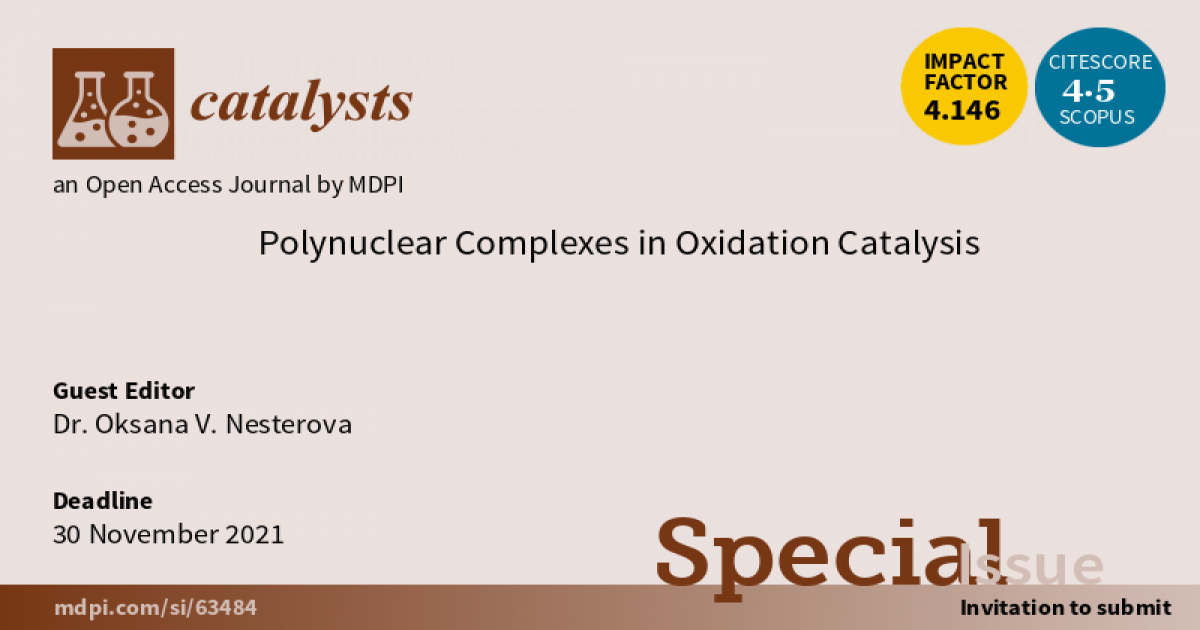Polynuclear Complexes in Oxidation Catalysis
A special issue of Catalysts (ISSN 2073-4344). This special issue belongs to the section "Catalysis in Organic and Polymer Chemistry".
Deadline for manuscript submissions: closed (30 November 2021) | Viewed by 7910

Special Issue Editor
Interests: coordination and inorganic chemistry; polynuclear homo- and heterometallic complexes; homogeneous catalysis; oxidative transformations; C–H activation
Special Issue Information
Dear Colleagues,
Catalytic oxidation is a process of fundamental significance in chemistry. From both organic and inorganic points of view, catalytic oxidation is a part of many laboratory and industrial protocols for a wide range of valuable products. Coordination compounds of transition metals are common catalysts for oxidative transformations, where the metal centre plays various roles, from the coordination of substrates and stabilization of intermediates to the activation of an oxidant. Polynuclear complexes, inspired by structures of enzymes’ active centres, could constitute next-generation catalysts. The presence of few metals at a close distance could promote the interaction between coordinated intermediates, enhancing the activity and opening new catalytic pathways.
This Special Issue welcomes contributions focused on investigation of the catalytic activity of polynuclear coordination compounds in a broad range of oxidative processes. This includes both inorganic (e.g., water oxidation) and organic (oxidation of functional groups, late stage functionalization, C–H activation, oxidative coupling, etc.) reactions of fundamental and applied interests.
Dr. Oksana V. Nesterova
Guest Editor
Manuscript Submission Information
Manuscripts should be submitted online at www.mdpi.com by registering and logging in to this website. Once you are registered, click here to go to the submission form. Manuscripts can be submitted until the deadline. All submissions that pass pre-check are peer-reviewed. Accepted papers will be published continuously in the journal (as soon as accepted) and will be listed together on the special issue website. Research articles, review articles as well as short communications are invited. For planned papers, a title and short abstract (about 100 words) can be sent to the Editorial Office for announcement on this website.
Submitted manuscripts should not have been published previously, nor be under consideration for publication elsewhere (except conference proceedings papers). All manuscripts are thoroughly refereed through a single-blind peer-review process. A guide for authors and other relevant information for submission of manuscripts is available on the Instructions for Authors page. Catalysts is an international peer-reviewed open access monthly journal published by MDPI.
Please visit the Instructions for Authors page before submitting a manuscript. The Article Processing Charge (APC) for publication in this open access journal is 2700 CHF (Swiss Francs). Submitted papers should be well formatted and use good English. Authors may use MDPI's English editing service prior to publication or during author revisions.
Keywords
- Polynuclear complexes
- transition metals
- homogeneous catalysis
- oxidation processes
- organic synthesis
- reaction mechanism
- kinetics





